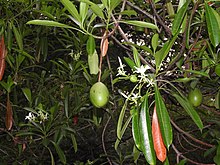Cerbera manghas
| Cerbera manghas | |
|---|---|

| |
| Scientific classification | |
| Kingdom: | Plantae |
| Clade: | Tracheophytes |
| Clade: | Angiosperms |
| Clade: | Eudicots |
| Clade: | Asterids |
| Order: | Gentianales |
| Family: | Apocynaceae |
| Genus: | Cerbera |
| Species: | C. manghas
|
| Binomial name | |
| Cerbera manghas | |
| Synonyms | |
|
Synonyms list
| |
Cerbera manghas,[1] the sea mango, is a small evergreen coastal tree growing up to 12 metres (39 ft) tall. It is native to coastal areas in Africa, Asia, Australasia, and the Pacific islands.
Description
The shiny dark-green leaves grow in a spiral arrangement, and are ovoid in shape. The flowers are fragrant, possessing a white tubular five-lobed corolla about 3–5 cm (1.2–2.0 in) in diameter, with a pink to red throat. They have five stamens and the ovary is positioned above the other flower parts. The fruits are egg-shaped, 5–10 cm (2.0–3.9 in) long. At maturity they turn bright red.
Toxicity
The leaves and the fruits contain the potent cardiac glycoside cerberin, which is extremely poisonous if ingested.
Long ago, people used the sap of the tree as a poison for animal hunting.[2]
Goffin's cockatoo is one of the creatures known to eat sea mangos.[3] In addition, the Coconut crab can become toxic to humans if it eats too much sea mango due to a buildup of cardiac cardenolides.
Gallery
-
Flower
-
Unripe fruit
References
- ^ POWO: Cerbera manghas L.
- ^ "Cerbera manghas L." Flora Fauna Web. Retrieved October 4, 2017.
- ^ Yirka, Bob (September 3, 2021). "Wild cockatoos observed making and using tools to eat sea mango pits". phys.org.
 Media related to Cerbera manghas at Wikimedia Commons
Media related to Cerbera manghas at Wikimedia Commons





